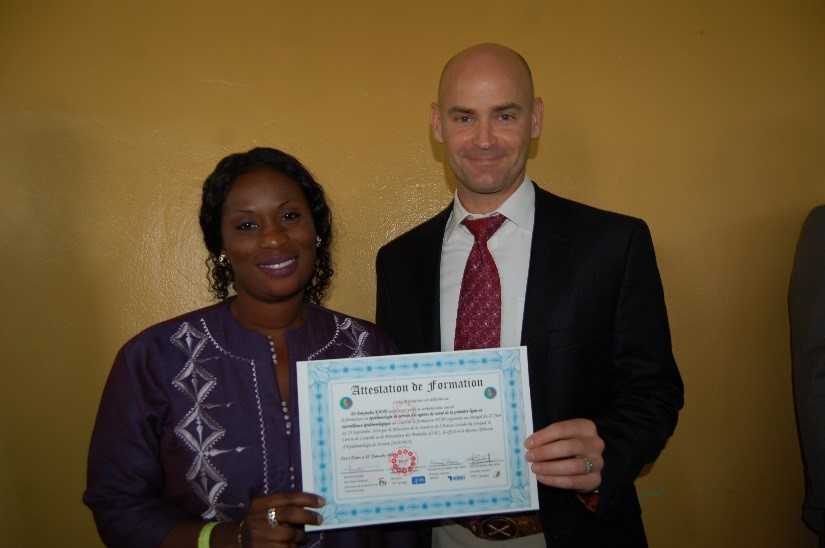Snow in Senegal
The Bottom Line
THE CHALLENGE: With nearly 100 cases of bloody diarrhea, a village in Senegal benefited from a trained epidemiologist and appropriate laboratory testing to identify the disease and find the source of infection.
THE SOLUTION: While participating in the Senegalese Frontline Epidemiology Training Program, one trainee, Dr. Dieynaba Kane, used her training and program resources to quickly identify and contain a very contagious disease outbreak.
Stopping a contagious illness often requires detective work, like that of the father of modern epidemiology, Dr. John Snow. In 1854 Dr. Snow, applying disease detection techniques, identified a well in the Soho district of London as the source of a cholera outbreak and removed the pump handle on the well to stop the outbreak. More than 160 years later, Dr. Dieynaba Kane, Deputy Chief Medical officer of the health district of Tivaouane in Senegal, emulated Dr. Snow’s work when she investigated and helped control a dysentery outbreak in 2016.
Each year, more than 6,000 people in Senegal suffer from dysentery, or bloody diarrhea. Dysentery is a common symptom of bacillary dysentery, a disease that may result in serious illness particularly among the very young and elderly. Outbreaks can result in large epidemics with many deaths, and when the disease is detected there is always an urgent need to rapidly investigate and control such outbreaks.
Dr. Kane, a trainee in the second cohort of the Senegalese Frontline Field Epidemiology Training Program (FETP), used program resources and knowledge from the training to investigate the cluster of nearly 100 cases of dysentery. She confirmed that these cases were part of an outbreak in one village, created a map of the daily whereabouts of each case, and investigated where they could have caught the disease. She also determined ways to prevent more people from getting sick and helped people in the village adopt new behaviors so that the bacteria could not make them sick in the future.
Dr. Kane’s disease detective work involved reviewing the clinic’s patient information and health staff interviews. Through her investigation she learned that 21 patients had dysentery from January through February 2016, and 68 more had dysentery in March. The patients came from different parts of the same village. Dr. Kane sent stool samples from ill persons to a nearby laboratory, and test results confirmed that the cause of the outbreak was Shigella dystenteria.
Finding Bacteria in the Water
Understanding that poor hygiene and contaminated water can lead to bacillary dysentery, Dr. Kane wanted to know if the source of the water, and the way villagers stored and used water, played a role in the illnesses. She learned that villagers got their water from three sources: two public wells (one with a pump) and a private well inside a local bakery. After looking at patient information, she learned that people who got water from the well with a pump were three times more likely to get sick than those who got water from one of the two wells. When Dr. Kane tested the water, she found that water from the well with a pump was contaminated with Shigella dystenteria.
Availability and storage of water was also a factor in the dysentery outbreak. People could get water from the well with the pump only from 7am to 9am. To have water on hand, people stored water in unwashed, uncovered containers for long periods and this allowed the bacteria to grow.
Preventing Future Illness
After learning that the well was the source of the bacteria and that the water storage methods contributed to disease transmission, Dr. Kane and her team took a page from Dr. John Snow’s book and had local authorities close the contaminated public well until it could be completely treated and was safe for public use. They also treated the other village water sources and instituted routine laboratory testing of each of the village water sources. She also provided recommendations on ways to improve water hygiene and storage practices, like distributing water treatment supplies.
About This Story
CDC is working with 31 priority countries to develop global health security capabilities, which protect Americans and people around the world from disease threats. This story illustrates Senegal’s commitment to:
- Workforce Development: Expanding the pool of skilled healthcare workers who can prevent, detect, and respond to outbreaks to keep a country and the world safer from diseases.
Stopping a disease outbreak at its source, like this dysentery outbreak in Senegal, is the most efficient way to control public health emergencies and ensure global health security. CDC will continue to work with the government of Senegal to strengthen the country’s public health workforce. This work ensures that Senegal, and therefore the global community, is safe from disease threats.

Dr. Dieynaba Kane at the FETP Frontline graduation ceremony with CDC Senegal Country Director, Dr. Michael Kinzer
- Page last reviewed: August 6, 2017
- Page last updated: August 6, 2017
- Content source:
Global Health
Notice: Linking to a non-federal site does not constitute an endorsement by HHS, CDC or any of its employees of the sponsors or the information and products presented on the site.


 ShareCompartir
ShareCompartir